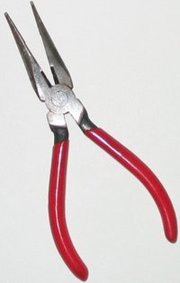Pliers
|
|
Pliers are hand tools primarily for gripping and cutting that use leverage and numerous different jaw configurations to grip, turn, pull, cut or crimp a variety of things. They are a tool common to many dexterous trades and occupations.
| Contents |
History
Pliers were first invented in Europe around 2000 BC to grip hot objects (principally iron as it was being forged on an anvil). Among the oldest illustrations of pliers are those showing the greek god Hephaistos in his smithy. Pliers intended principally to be used for safely handling very hot objects are usually called tongs. The number of different designs of pliers grew together with the invention of the different objects for which they were used: horse shoes, fasteners, wire, pipes, electrical and electronic components. Because of the multitude of possible objects and operations, the variety of pliers today probably exceeds all other types of hand tools (screwdrivers are always for screws, saws for sawing, hammers always for striking, etc.)
Lockjawpliers.jpg
Design
The basic design has changed little since its origins, with the pair of handles, the pivot (often formed by a rivet), and the head section with the gripping jaws or cutting edges forming the three elements. In distinction to pair of scissors or shears the plier's jaws always meet each other at one point.
In technical terms, pliers are an instrument that converts a power grip, the curling of the fingers into the palm of the hand, into a precision grip, which as the name suggests directs the power of the hand's grip in a precise fashion. The long handles relative to the short nose of pliers act as levers concentrating, and in effect amplifying the force in the hand's grip on a workpiece.
Common types
Cutting pliers (used to sever or pinch off)
- Side cutting pliers or linesmen's pliers
- Diagonal cutters
- Pinching pliers
Gripping pliers (used to improve grip)
- Flat nose pliers
- Round nose pliers
- Long-nose or needle nose pliers, which have long, narrow jaws for gripping in confined spaces
- Water pump pliers - with adjustable jaw sizes, which are designed to grip various sizes of round, hexagon, flat or similarly shaped objects
- Retaining ring or circlip pliers, which are used for fixing or loosening retaining rings
- Locking pliers
Crimping pliers
- For crimping electrical terminals and connectors (solderless connections)

